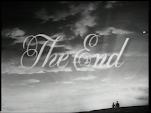
The fantastic tag-line for Hal Hartley's The Unbelievable Truth (1989) is "Can a nice girl from Long Island find happiness with a mass murderer?" This has little relevance to this post other than the fact that the line suggests (somewhat misleadingly, as it turns out) that this film may bring together conventions from two genres which together provided me with a term that became central to my PhD thesis: the 'final couple'. Since this is a phrase I'll likely be bandying about on this blog, I thought I would introduce it.
Not that it needs much in the way of introduction, being already fairly self-explanatory. The final couple is essentially my term for the-romantic-couple-as-ending: the moment just prior to the conclusion of so many films at which 'boy gets girl'. Since it is routinely considered such a standard feature of Hollywood happy endings, I chose this convention as the focus for my thesis, and dedicated myself in large part to investigating the flexibility of this seemingly most inflexible of tropes.
In her excellent book Men, Women, and Chain Saws Carol Clover coined the term ‘Final Girl’ to refer to the heroine of the slasher film, a female character who ultimately survives the killer’s murderous rampage, and often dispatches him. While it clearly has its origins in very different traditions than those with which my thesis is concerned (focused as my work is mainly on romantic comedies and melodramas), there are nevertheless a few ways in which the conventions of the ‘Final Girl’ and the final couple are suggestively related.
(1) Obviously referring to endings in its very wording, the term ‘Final Girl’ also particularly refers, in its own way, to a type of ‘happy ending’: the killer’s threat eliminated (or at least temporarily overcome), this indomitable character may go on living her life.
(2) Just as we will usually be able to predict the putative outcome of a slasher film by quickly recognising who will likely become the ‘Final Girl’ (often distinguished, says Clover, by features such as her virginity and her tomboy appearance), so in a romantic comedy will we virtually always be able to predict which characters will make up the final couple. This fact has similar significance for audience expectations and thus narrative drive in both genres, as I explore in the thesis in relation to closure in romantic comedy.
(3) The sexual politics of the end of a slasher film (a male violent/sexual threat to women having been overcome by a resilient female) constitute a very different treatment of similar ideological issues addressed in the image of the final couple. Whereas sexual difference in the slasher film requires a fight to the death, in the romantic comedy it may be overcome through a far safer ‘battle of the sexes’ which tends to result in an either utopian or uneasy union. That the ‘happy ending’ of the slasher film usually constitutes a woman managing to rid herself of a man, rather than uniting with one, is indicative of the different approaches used by two genres working through comparable ideological terrain. As Robin Wood says, looked at ideologically, genres are seldom discrete, but rather “represent different strategies for dealing with the same ideological tensions”.
Though I don't investigate the parallels much further than this in the thesis, there is more to be said about the relationship between these two 'final' conventions - something I may well attempt here in the future.
.

Im glad I gave that dvd back to you.
ReplyDelete